After completing the original NES Final Fantasies, I'm currently two for three on enjoyable experiences. But the SNES years? I say with full confidence that these are some of the best Final Fantasy games in existence. Without further ado, let's dive in!
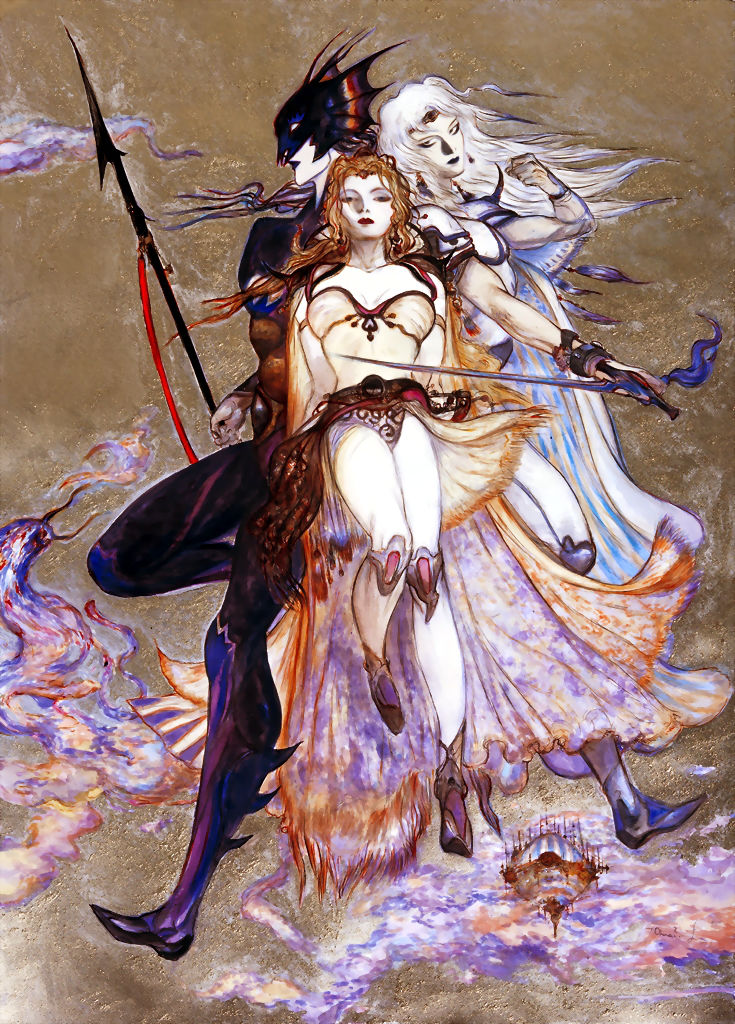
Kain, Rosa, and Cecil by Yoshitaka Amano
Final Fantasy IV, originally released as Final Fantasy II in the U.S., really brought RPGs to a whole new level. Having played this game back in the day on the Game Boy Advance, it was truly a delight to revisit this particular entry.
Let's start with the story. Like I mentioned above, Final Fantasy IV really broke new ground with its story. While Final Fantasy I and III were rather bare bones, and Final Fantasy II was a total dumpster fire, Final Fantasy IV presents a truly engaging story, with characters that you really fall in love with. Cecil, our main protagonist, actually begins the game fighting alongside the evil empire. After witnessing too many heinous events, he goes on an epic quest to redeem himself, in turn shedding off his persona of a Dark Knight, and embracing the chivalrous role of a Paladin. Alongside Cecil are Rosa, his love; Kain, Cecil's best friend who is torn between fighting for himself and loyalty to his country; Rydia, the last of a clan of summoners, and Edge, the ninja prince of Eblan. All of these characters have their own reasons for fighting along Cecil, and each brings an interesting new dynamic to the party. Alongside the main cast, Final Fantasy IV features a large ensemble of diverse characters. Some travel alongside Cecil for a short time, while others provide valuable support to the team. Even the main villain Golbez is a deep character, with his own set of morals and a shocking backstory.
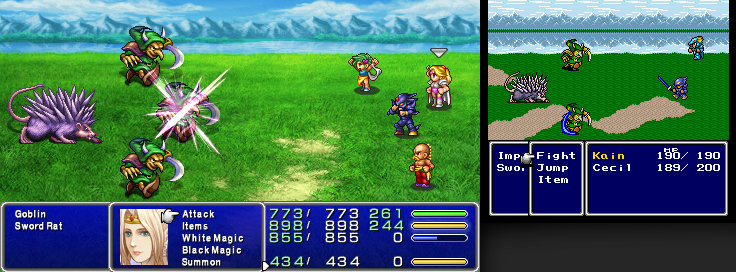
Final Fantasy IV Screenshots (PSP and SNES)
Final Fantasy IV set the standard for what's expected in a modern JRPG story. No longer did players have to deal with your average, "save the world" story. Now stories had depth, with interesting characters and a world that had a long and storied past. Square just HAD to go and spoil us!
Gameplay-wise, Final Fantasy IV still holds up extremely well to this day. Combat runs smoothly, albeit a little slowly, and attacks and spells are easily understandable. One of the more interesting things about Final Fantasy IV was how the player's party consisted of five characters, rather than the series' standard of three-to-four-person teams. This concept has yet to be revisited in later Final Fantasy games, which is a shame. Modern Final Fantasies include a great deal of character customization, and allowing players to use five characters would add a new level of strategy when entering battles. Unfortunately, this combination of customization and larger parties was not utilized in Final Fantasy IV: for all the good things Final Fantasy IV brings to the table, it contains, by far, one of the most rigid parties. While later remakes of Final Fantasy IV would allow players to switch up their party right before the final dungeon, the original game's endgame party was story-fixed. While they fill out a solid group, consisting of a Paladin, Dragoon, White Mage, Black Mage, and Ninja, you couldn't pick and choose abilities and skills for the characters. Yes, there was a side quest that allowed you to collect optional summons, but when compared to the job system of Final Fantasy III, or later systems like Materia or the Sphere Grid, players didn't get much of a say in how their characters were built.
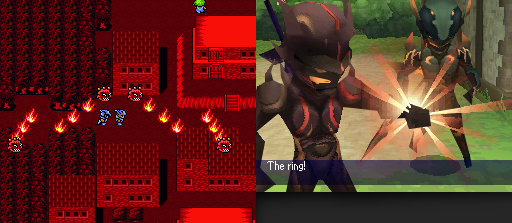
Final Fantasy IV Screenshots (SNES and DS)
Lack of customization, however, is the only downside I can think of for this game. Final Fantasy IV is truly a delight, featuring solid gameplay and a story that will stay with you long after it's done. If you've yet to try it out, I BEG you, please play Final Fantasy IV. Even if you don't have a SNES, this game has been ported to the Game Boy Advance, Nintendo DS, the PlayStation Portable, and even PC via Steam. Do yourself a favor, and get a copy!

Final Fantasy V Cast by Yoshitaka Amano
With Final Fantasy V, Square finally figured out the perfect blend for an RPG. Combining the best elements of both III and IV, Final Fantasy V is a textbook example of how to make a good RPG.
The game starts off with the adventure Bartz — comically translated as Butz when first released in America — witnessing a meteorite crash near him. Upon further investigation, Bartz discovers Lenna, the princess of Tycoon, and Galuf, an older man suffering from a bout of amnesia. Along with the pirate Faris, and Krile, a mysterious young girl, these adventurers are tasked with protecting the world's crystals from impending doom.
Where Final Fantasy V really shines is in its gameplay. While Final Fantasy IV was much more rigid, Final Fantasy V allows, by far, some of the most intricate customization available in the series. Using a remastered version of Final Fantasy III's job system, players can choose up to 26 classes in order to fill out their party. Fan favorite classes like the Black Mage and Thief make a triumphant return, while also introducing new classes like the Blue Mage and Mimic, which would become beloved in their own right. With two different tiers for characters and their jobs, players are able to eventually mix and match class skills to their choosing, allowing interesting combinations, such as a Knight who can use black magic, or a Thief who can mimic abilities. While you always have a party of four characters, the amount of customization with the job classes takes things to a new level.

Final Fantasy V Screenshots (GBA)
It's strange for me to talk about Final Fantasy V, for while it is a solid game in all aspects, it kind of feels like the middle child of the Final Fantasy family. Even though it sold very well during its initial release and in all further remakes, being sandwiched in between the masterpieces that are Final Fantasy IV and VI makes it lose some of its luster, which is very unfortunate. If it had been the first game released for the SNES, I truly feel that Final Fantasy V would get the attention it deserves. But as it stands, Final Fantasy V tends to fall to the wayside for no fault of its own.
I highly suggest playing Final Fantasy V, if you haven't had the chance yet. While it may seem a little underwhelming by today's standards, its masterful gameplay and enticing story make this an unmissable game. Also, we get our first introduction to Gilgamesh, who is by far one of the best recurring characters in the Final Fantasy universe!
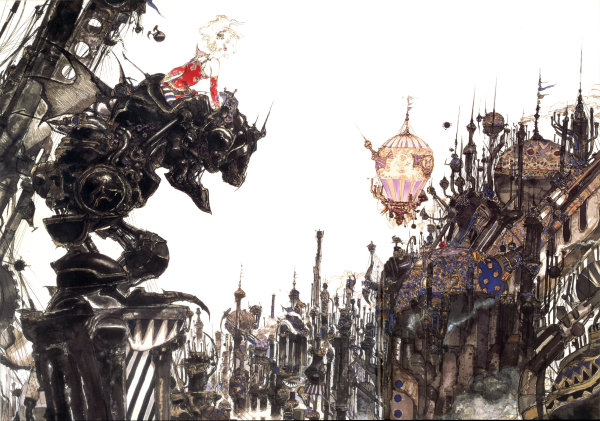
Terra and Magitek by Yoshitaka Amano
What can be said about Final Fantasy VI that hasn't been said plenty of times before? It's by far considered one of the best Final Fantasy games by the fandom, and for very good reasons.
I'd like to start off by discussing the story of Final Fantasy VI, as I feel it's the strongest point of the game. It's funny, because my instinct is to focus the story around the point of view of the main character, but Final Fantasy VI doesn't really have a main character, if you will. While the game starts off with players in control of Terra, a young woman under the control of the evil Gestahl Empire, we're soon introduced to a plethora of playable characters, each of whom have their own moments in the spotlight. Final Fantasy VI actually boasts an impressive 14 playable party members, a number which has yet to be broken by any other mainline Final Fantasy game. None of these characters feel useless either, as they each bring something different to the table, like Mog, who learns new dances depending on the terrain he battles on, and Relm, who makes sketches of enemies and deals damage through her artwork. All of these characters are fascinating and different, and since they're permanent members of the party, players are given a great amount of freedom in their party composition.
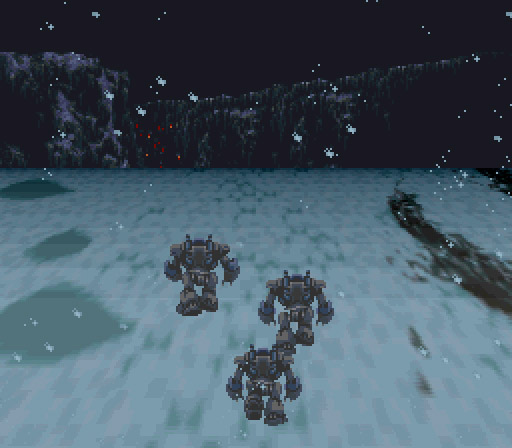
Final Fantasy VI Screenshot (SNES)
The world of Final Fantasy VI itself was extremely unique for its time. Casting off the shackles of traditional fantasy tropes, Final Fantasy VI goes all in on the steampunk aesthetic, featuring robots, chainsaws, and all sorts of environments that hadn't often been featured in RPGs. While games like Shin Megami Tensei may have done it first, Final Fantasy VI really brought the idea of steampunk in an RPG into the mainstream.
Before we start this next section, I'm going to give everyone a BIG spoiler warning. If you'd like to experience Final Fantasy VI for yourself, I highly suggest you skip the next paragraph.

Celes Chere by Yoshitaka Amano
One of the most amazing things about Final Fantasy VI, from a story perspective, is how we get to see the main villain actually win. Halfway through the game, the party is unable to stop the villain's plan, and the world is literally changed into a World of Ruin, where Kefka — who until this point seemed simply to be a maniacal court jester — becomes a literal god. Our brave party of adventurers are scattered across the earth, with some of them even potentially dying, depending on the player's choices. It's here where Final Fantasy VI takes a drastic turn, changing from a story of resistance to a story of hope. In order to save this ruined world, each of the playable characters must come to terms with their mortality and failures, and rise up to continue the fight. These events, unique to each playable character, are truly inspiring, and give depth to these characters the likes of which hadn't been seen before. The bonds that unite this party are strong and genuine, and as you make your way towards the end of the game, you as the player will want to save this world just as badly as the party. It's an emotional experience, and one that I hardly find emulated even in modern games.
I've touched on gameplay a bit earlier in the article, but I do want to go in depth about how Final Fantasy VI makes great use of its large party. There is no traditional job system, like what we've seen in Final Fantasy III and V, but the large cast does have plenty of similarities to jobs we've seen before in the series, Like Shadow being a classic Ninja, and Sabin being very similar to a Monk. How these characters play, however, is very different from what we've seen before. Going back to Sabin for a moment, his special ability, Blitz, requires actual directional input to pull off, similar to the special moves of fighting games. As magic is very rare in this world, only a handful of characters have innate magical proficiency, yet players are able to overcome this limitation through accessories and Magicite. Even a melee bruiser like Sabin can become a decent spellcaster with the right customization. This is somewhat similar to the Materia and Sphere Grid systems we would see in later entries, but for a first-time feature, Final Fantasy VI really hit the nail on the head.
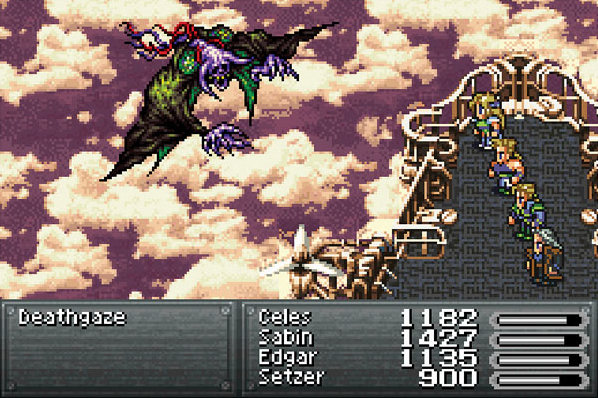
Final Fantasy VI Screenshot (GBA)
Final Fantasy VI is a must-play. It's featured on many different "Top X RPGs" lists around the web, and deservedly so. With an intense story, lovable characters, and surprisingly in-depth combat, Final Fantasy VI rightly earns its place along such legendary titles as Chrono Trigger. It's not even an option at this point: if you love RPGs, you must play Final Fantasy VI.








